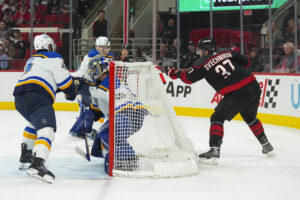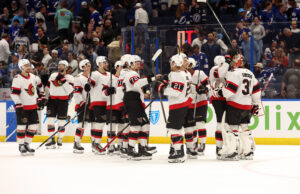Previously mentioned in projecting Team USA’s 2022 roster, Finland last medaled in Men’s Olympic Hockey in 2014 for Olympic Bronze. Though the Olympics showcase players from multiple international professional leagues, NHL players are no doubt the premier talents. Only 60 percent of Finland’s 2014 roster were current NHL players which makes it remarkable they were able to beat a completely NHL-composed Team USA. Particularly, even more remarkable, Finland upset Russia in the quarterfinals. They fell just one game short of taking on Canada for Gold. Led by the ascension of superstars Aleksander Barkov, Mikko Rantanen, and Sebastian Aho, international Finnish hockey is on a tremendous upward trajectory.
Projecting the 2022 Finland Hockey Olympics Roster
The Forwards
In the midst of a disgruntled relationship with then Anaheim Ducks coach Bruce Boudreau, 43-year-old Teemu Selänne used the international stage to reaffirm his ability and won tournament MVP. Though productive in his elder years, no one is confusing 43-year-old Selänne to prime “Finnish Flash” Selänne. To the same accord, no one is confusing 2014 rookie Barkov to present-day superstar Barkov. The 2014 Fins were able to succeed without any NHL star forwards in their prime. Now in 2022, Finnish GM Jere Lehtinen and AGM Jarmo Kekäläinen will have multiple legitimate Finnish NHL stars on their roster. The ages listed are the players’ ages at the time of the 2022 Beijing Olympics, February 4th-February 20th, 2022.
Centers
Top Six
Aleksander Barkov, C (26): Barkov has cemented himself as a top 10 NHL center and one of the best players in the world. He finished the 2020-21 season with 26 goals and 32 assists in 50 games. That was good for 4th in goals for centers and 7th in points. The underlying stats further show Barkov is an elite offensive threat as he has one of the highest Expected Goals For and Corsi For per 60. Barkov further developed his defensive game, which lacked in previous years. That shows through his positive impact on expected goals against and Corsi against per 60.
Sebastian Aho, C (24): Just behind Barkov for best Finnish center, Aho finished the 2020-21 season a top 20 NHL scorer with 24 goals and 33 assists in 56 games. Over the past three seasons, only 14 players have more points than Aho and only 12 have more even-strength goals. Aho also made good strides in improving his defensive game this year. That is evident through his massively improved Expected Goals Against and Corsi Against per 60.
Bottom Six
Roope Hintz, C (25): Despite playing through the entire season with a nagging injury, Hintz was able to achieve a tremendous breakout year with 43 points in 41 games. Hintz was able to go on a 96 point pace while injured. It’s exciting to think of what he could do fully healthy on the international stage. Hintz also showed he can hold his own defensively, turning in a positive xGA/60 and CA/60.
Jesperi Kotkaniemi, C (21): His offensive production has yet to break out the way Canadiens’ fans have hoped, but outside a bad 2019-20 season Kotkaniemi has been strong defensively. This past season, Kotkaniemi turned in positive xGA/60 and CA/60. Throughout his offensive struggles, Kotkaniemi has still had a positive impact on his team. This past season, the Canadiens controlled 53.3 percent of on-ice expected goals with Kotkaniemi on the ice. That dropped to 47.9 percent with him off the ice.
Anton Lundell, C (20): Florida’s 12th overall pick in the 2020 draft, Lundell had a strong Liiga season for HIFK Helsinki, scoring 16 goals and 9 assists in 26 games. Though Lundell is yet to make the NHL jump, Jokke Nevalainen of Dobber Prospects describes him as: “a very smart and reliable two-way center with upside to become a number one center and a Selke Trophy contender.” Further, Lundell recorded a 60.7 Corsi for percentage in 2o20-21. That ranked eighth for Liiga players who played at least 10 games.
Wingers
Top Six
Mikko Rantanen, RW (25): Fifth in the league in scoring in 2020-21 with 66 points in 52 games, Rantanen had more points than notables Crosby, Barkov, Scheifele, and Aho. The highest scoring Fin in the NHL and easily one of the league’s best wingers, Rantanen still ranks 24th in points in the NHL over the past 3 seasons despite missing considerable time in 2019-20. Colorado registered an astounding 72 percent of on-ice expected goals with Rantanen on the ice. That’s compared to 52.5 percent with him off the ice. Not only does he register elite advanced offensive metrics, but Rantanen was excellent defensively this year.
Teuvo Teräväinen, LW (27): Injuries plagued his 2020-21 season, but the previous 3 seasons “Turbo” Teräväinen scored 203 points in 232 games and was a legitimate two-way threat. Teräväinen consistently posts strong Corsi for percentages and Fenwick for percentages. This demonstrates his impact on his team controlling play with him on the ice. A testament to his playmaking ability, Turbo recorded more primary assists than teammate and countryman Aho in both 2018-19 and 2019-20.
Jesse Puljujärvi, RW (23): Though he had just 25 points in 55 games, Puljujärvi was on track to surpass the 20 goal mark over a full season for the first time in his short career. Connor McDavid was the only 2020-21 Oilers regular with a better Corsi for percentage, Fenwick for percentage, and expected goals for percentage than Puljujärvi. On the defensive side, no Oilers forward had a better xGA/60 than Puljujärvi. Puljujärvi is developing into a very good two-way player and with some improved finishing ability alongside Barkov or Aho; he could really shine.
Kaapo Kakko, RW (20/21): His 17 points in 48 games this past year don’t tell Kakko’s full story. After an abysmal rookie season where he put up a 44.1 CF% and a 42.8 FF%, Kakko improved to a 53.9 CF% and a 54.4 FF%. Kakko had the best possession metrics on the entire 2020-21 New York Rangers, +8% relative to his team. Defensively, no Rangers forward was better than Kakko which is seen through his forward best CA/60 and xGA/60. Kakko’s sharp defensive and possession game would pair well with Aho. Aho’s offensive game could allow Kakko to rediscover his pre-draft scoring ability.
Bottom Six
Patrik Laine, RW (23): Virtually all Laine has shown he can do at the NHL level is score goals. He’s awful defensively, doesn’t drive offensive play, and is an overall tank on the possession game. So why does Finland include him? If Laine can be heavily sheltered in a fourth line or extra role, he can be used successfully as a powerplay specialist. It wouldn’t be exposing too many of his deficiencies.
Kasperi Kapanen, RW (25): His advanced metrics can be scrutinized, but Kapanen remains a very opportune player who scored at a 61 point pace over a full season this year. His slightly negative to average at best CF%, FF%, CF/60, xGF%, CA/60, and xGA/60 suggest that Kapanen doesn’t excel at driving play or limiting chances. However, Kapanen’s team still scores more than they give up with him on the ice with a 64.71 GF% in 2020-21. At its most basic form, winning is scoring more than you give up.
Joonas Donskoi, RW (29): In a shortened 2020-21 season, Donskoi produced 17 goals and 14 assists in 51 games. This averages to approximately 27 goals and 49 points over a full 82 game schedule. That would be a career year for Donskoi. In his first year on Colorado in 2019-20, his defensive game fell off a cliff. But it rebounded enough this year to not be detrimental to his team’s success. Donskoi makes 5v5 depth minutes count and overachieved with an excellent 68.18 GF% on a still very good 57.09 xGF%.
Eeli Tolvanen, RW (22): Still yet to breakout, the talented Tolvanen finally showed signs of his draft hype scoring 22 points in 40 games with the Predators this year with more than half coming on the powerplay. Tolvanen’s advanced metrics are largely average. But it is worth noting his defensive play this season has been positive in terms of xGA/60 and CA/60. It is also worth considering Tolvanen’s success has happened despite Nashville’s centers being largely underwhelming.
Mikael Granlund, LW/C (29): One of Nashville’s aforementioned underwhelming centers, Granlund would do better with a shift back to wing on team Finland. Granlund spent much of 2020-21 as Nashville’s second-line center. It was a trying effort with poor CA/60, xGA/60, and xGF% metrics. Granlund did overachieve with his team scoring 55.77 GF% against a 47.84 xGF% with him on the ice. A three-year weighted average shows Granlund isn’t as bad defensively as this year suggests. Perhaps the lightened responsibility on the wing could rebound his play. Offensively he still has some kick, averaging 43 points over a full year’s schedule.
Defence
Finland’s defence is without a doubt their only positional concern. Finland’s offence and goaltending may be enough to supplant potential defensive shortcomings. But they will still need a strong showing from Miro Heiskanen. With many unproven players on their backend, it will also be a chance for unheralded players to shine against the world’s best.
Top Four
Miro Heiskanen, RD/LD (22): Finland’s clear-cut number one defenseman will have a lot to prove after spending his entire career behind John Klingberg. Heiskanen averaged 40 point pace over a full season this year. He turned in a positive CF%, positive FF%, and showcased his undeniable raw skill. His poor 46.15 GF% this past season is due to rebound closer to his 53.27 xGF%. Heiskanen has been good so far in his short career. He’ll have to take a further step next year to truly demonstrate his elite top-pairing projection.
Esa Lindell, LD (27): Lindell is a mostly one-dimensional defensive defenseman who has familiarity with Dallas teammate Heiskanen. Lindell stayed competitive against other teams’ top competition this year. He registered the second-best xGA/60 for Dallas defensemen and positive CF%, FF%, GF%, and xGF% metrics. The success of Lindell on the top pairing will be predicated on his defensive ability to limit chances while allowing Heiskanen to carry the offensive play.
Juuso Välimäki, LD (23): After losing his entire 2019-20 season due to an ACL injury, Välimäki had a nice comeback season on Calgary. Playing mostly third-pairing minutes, Välimäki had a 53 CF%, 51.8 FF%, and a 53.54 xGF%. Though his offensive production has yet to translate at an NHL level, Välimäki did record 19 points in 19 Liiga games this year before the NHL season began. A larger role on Team Finland and a pairing with a more defensively adept defenseman could lead to more production for Välimäki.
Markus Nutivaara, LD (27): His 10 assists in 30 games may not say much, but the metrics show Nutivaara had a very promising season on the Florida Panthers. In largely a third-pairing role, Nutivaara posted a 54.69 CF%, 54.83 FF%, and 54.76 xGF% during the regular season. He continued his strong play into the playoffs. On the defensive spectrum, Nutivaara ranked second for Panther’s defenseman in CA/60 and ranked third in xGA/60.
Bottom Four
Ville Heinola, LD (20): Still waiting to break into the NHL with Winnipeg, Heinola hit his stride in both the Liiga and AHL this season. In the Liiga, Heinola recorded 14 points in 19 games and had the highest Corsi for regulars on his team. LWOS’ Ben Kerr does an excellent breakdown of Heinola’s strengths that are highlighted by his cerebral play and mobility. Heinola has top-four NHL potential and could be a solid depth option for Finland.
Jani Hakanpää, RD (29): Hakanpää’s point totals and possession metrics demonstrate he provides next to nothing offensively. However defensively, Hakanpää uses his large 6′ 5″ frame well to take up space and limit chances. For defensemen who played at least 200 minutes in the 2020-21 NHL season, Hakanpää recorded the 41st best xGA/60 and the 67th best CA/60. Both those rankings are impressive considering 232 defensemen played at least 200 minutes this season. Hakanpää would provide strong defensive stability alongside a younger puck mover.
Robin Salo, LD (23): A second-round draft pick by the New York Islanders in 2017, Salo continued his positive development in the Swedish Hockey League, emerging as a top defenseman while tying for 9th in scoring for defensemen. Though he had eight fewer points than the leading SHL defenseman and fellow Fin Jesse Virtanen, Salo is younger with a very real NHL projection as a top-four, two-way defenseman.
Oliwer Kaski, RD (26): Kaski was 7th in the KHL for scoring by defensemen in 2020-21, with 34 points in 58 games. Using Dobber Prospects’ NHLe calculator, that translates to 39 points over a full 82 game NHL season. In addition to the KHL, Kaski has seen offensive success in both the Liiga and AHL. Kaski could be plugged into the lineup should Finland want more production from their backend.
Goalies
If Finland’s defence fails to stand up to offensive juggernauts Canada, Russia, Sweden, and the USA, they have a last line of defence in their strong goaltending. Tuukka Rask returns from 2014’s team while Juuse Saros and Kevin Lankinen replace former NHLers Kari Lehtonen and Antti Niemi.
Tuukka Rask (34): Despite what some Boston fans on Twitter may have you think, Rask has remained an elite goaltender into his 30s. Rask found himself just outside the top 10 this year in Goals Saved Above Expected after being second to only Connor Hellebuyck in 2019-20 with 17.7 GSAx. A hallmark of consistency, Rask has achieved a save percentage of .912 or better in each of his 12 seasons. Rask will provide Finland strong starts whether it be as the starter or backup to Saros.
Juuse Saros (26): After spending the start of his career behind Pekka Rinne. Saros has claimed Nashville’s net and cemented himself as a true number one. In 2020-21, Saros recorded a .927 save percentage and the fifth-best GSAx 2020-21 with 13.2 GSAx. Saros is looking like the next best Finnish goalie not only in Nashville but the entire world.
Kevin Lankinen (26): Thrust into the starting role for Chicago seemingly out of nowhere, Lankinen exceeded most everyone’s expectations. Lankinen’s .909 save percentage and GSAx certainly aren’t impressive alone. However, Lankinen stole more than a few games for Chicago who provided him little to no help defensively. The 2020-21 Blackhawks had a worse xGA/60 and CA/60 than every team except Vancouver. On Team Finland Lankinen doesn’t have to be anything more than a third-string. But if injuries hit he has shown he can respond in less than ideal circumstances.
Lines
Rantanen-Barkov-Puljujärvi
Teräväinen-Aho-Kakko
Kapanen-Hintz-Donskoi
Granlund-Kotkaniemi-Tolvanen
Lindell-Heiskanen
Nutivaara-Välimäki
Heinola-Hakanpää
Saros, Rask
Extras: Laine, Lundell, Salo, Kaski, Lankinen
Advanced Stats Referenced: Evolving Hockey, Natural StatTrick, Money Puck, Liiga
Main Photo:
Embed from Getty Images






